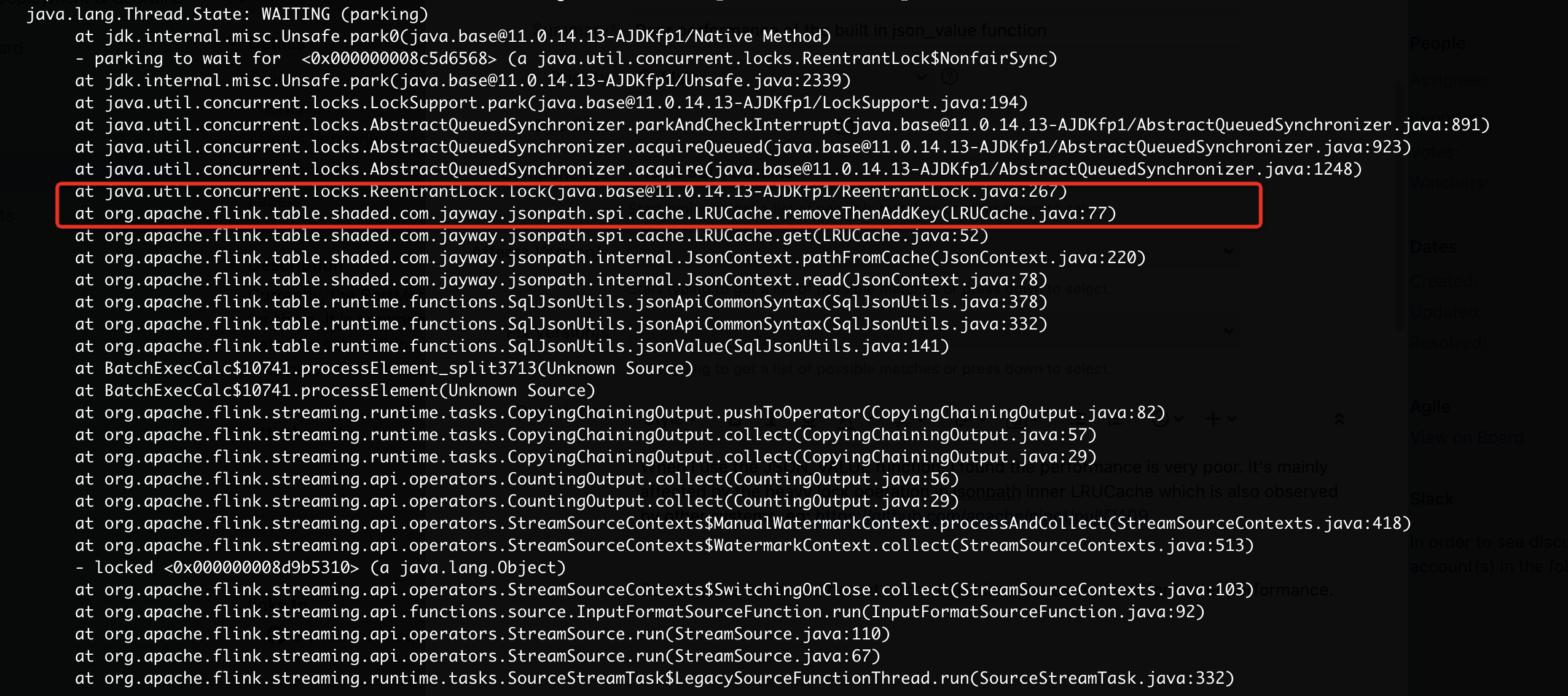使用jmh框架進行benchmark測試
效能問題
最近在跑flink社群1.15版本使用json_value函數時,發現其效能很差,通過jstack檢視堆疊經常在執行以下堆疊

可以看到這裡的邏輯是在等鎖,檢視jsonpath的LRUCache
//
// Source code recreated from a .class file by IntelliJ IDEA
// (powered by FernFlower decompiler)
//
package org.apache.flink.table.shaded.com.jayway.jsonpath.spi.cache;
import java.util.Deque;
import java.util.LinkedList;
import java.util.Map;
import java.util.concurrent.ConcurrentHashMap;
import java.util.concurrent.locks.ReentrantLock;
import org.apache.flink.table.shaded.com.jayway.jsonpath.JsonPath;
public class LRUCache implements Cache {
private final ReentrantLock lock = new ReentrantLock();
private final Map<String, JsonPath> map = new ConcurrentHashMap();
private final Deque<String> queue = new LinkedList();
private final int limit;
public LRUCache(int limit) {
this.limit = limit;
}
public void put(String key, JsonPath value) {
JsonPath oldValue = (JsonPath)this.map.put(key, value);
if (oldValue != null) {
this.removeThenAddKey(key);
} else {
this.addKey(key);
}
if (this.map.size() > this.limit) {
this.map.remove(this.removeLast());
}
}
public JsonPath get(String key) {
JsonPath jsonPath = (JsonPath)this.map.get(key);
if (jsonPath != null) {
this.removeThenAddKey(key);
}
return jsonPath;
}
private void addKey(String key) {
this.lock.lock();
try {
this.queue.addFirst(key);
} finally {
this.lock.unlock();
}
}
private String removeLast() {
this.lock.lock();
String var2;
try {
String removedKey = (String)this.queue.removeLast();
var2 = removedKey;
} finally {
this.lock.unlock();
}
return var2;
}
private void removeThenAddKey(String key) {
this.lock.lock();
try {
this.queue.removeFirstOccurrence(key);
this.queue.addFirst(key);
} finally {
this.lock.unlock();
}
}
private void removeFirstOccurrence(String key) {
this.lock.lock();
try {
this.queue.removeFirstOccurrence(key);
} finally {
this.lock.unlock();
}
}
...
}
可以看到get操作時,如果獲取到的是有值的,那麼會更新相應key的資料從雙端佇列移到首位,藉此來實現LRU的功能,但是這樣每次get和put操作都是需要加鎖的,因此並行情況下吞吐就會比較低,也會導致cpu使用效率較低。
從jsonpath社群檢視相應的問題,也有相關的反饋
https://github.com/json-path/JsonPath/issues/740
https://github.com/apache/pinot/pull/7409
比較方便的是,jsonpath 提供了spi的方式可以自定義的設定Cache的實現類,可以通過以下方式來設定新的cache實現。
static {
CacheProvider.setCache(new JsonPathCache());
}
從pinot的實現中,我們看到他是用了guava的cache來替換了預設的LRUCache實現,那麼這樣實現效能優化有多少呢,這裡我們是用java的效能測試框架jmh來測試下效能提升的情況
效能測試
這裡為了方便,直接在flink-benchmark工程裡新增了兩個benchmark的測試類.
GuavaCache
LRUCache
這裡面需要注意,因為cache是程序級別共用的,所以我們需要將設定@State(Benchmark)級別,這樣我們構建的cache就是程序級別共用,而不是執行緒級別共用的。
寫的測試是4個執行緒執行,快取大小均為400
為了避免在本機執行時受本機的其他程式影響,最好是build jar之後放到伺服器上跑
java -jar target/benchmarks.jar -rf csv org.apache.flink.benchmark.GuavaCacheBenchmark
得到一個測試結果
Benchmark Mode Cnt Score Error Units
GuavaCacheBenchmark.get thrpt 30 4480.563 ± 203.311 ops/ms
GuavaCacheBenchmark.put thrpt 30 1774.769 ± 119.198 ops/ms
LRUCacheBenchmark.get thrpt 30 441.239 ± 2.812 ops/ms
LRUCacheBenchmark.put thrpt 30 350.549 ± 12.285 ops/ms
可以看到使用guava的cache後,get效能提升8倍左右,put效能提升5倍左右。
這塊效能提升的主要來源是cache的實現機制上,和caffeine 的作者在github上也簡單瞭解了下相關的推薦實現
後面會寫一篇文章來專門分析下caffeine cache的優化實現。
參考
https://github.com/ben-manes/caffeine/wiki/Benchmarks caffeine benchmark
https://github.com/ben-manes/caffeine/blob/master/caffeine/src/jmh/java/com/github/benmanes/caffeine/cache/GetPutBenchmark.java caffeine benchmark
https://www.jianshu.com/p/ad34c4c8a2a3 jmh 框架常見引數
http://hg.openjdk.java.net/code-tools/jmh/file/tip/jmh-samples/src/main/java/org/openjdk/jmh/samples/ jmh 常見用例
本文來自部落格園,作者:Aitozi,轉載請註明原文連結:https://www.cnblogs.com/Aitozi/p/16560168.html